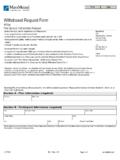Transcription of NATIONAL TREASURY
1 NATIONAL TREASURY 1 ECONOMIC MEASURES FOR COVID-19 2 Introduction The COVID-19 pandemic is simultaneously a health crisis and a global economic crisis. Led by the President, government has acted decisively to prioritise the health and lives of all South Africans. Yet the economy, which was already weak before the emergence of the pandemic, has been hit by interlocking shocks to supply and demand. The immediate priority is to use the joint levers of fiscal and monetary policy to support economic activity and alleviate hardship . Government has adopted a risk-adjusted approach to reopening the economy, with the initial easing of lockdown measures on 1 May.
2 This document sets out a 3-phase approach to government s economic interventions over the next 18 months a period during which the most severe effects of the public health crisis are expected to be resolved. This must, however, not compromise fiscal sustainability, which will ensure South Africa s long-term prosperity. As the President noted in his 21 April address, over the longer term, the South African economy cannot merely return to where it was before the pandemic. Forging a new economy in a new global reality will require a social compact between business, labour, communities and government.
3 It will require far-reaching structural reforms enabling millions of South Africans to participate in building a more productive and prosperous society. It will require steps to reimagine government s industrial strategy and overhaul state-owned enterprises. In the coming months, a special adjustment budget will set out a range of economic reform proposals and measures to stabilise the public finances. Figure 1: Summary of short-term economic support measures The R500 billion fiscal support package combines revenue and spending measures, as well as loan guarantees, totalling about 10 per cent of GDP.
4 This is larger than equivalent support measures announced by other emerging markets in the Group of 20. This amount is the result of a careful balancing act of fiscal sustainability and the need to ensure that productive economic capacity is not lost. COVID-19 pandemic is a health and economic crisis Immediate priority is supporting livelihoods but fiscal sustainability required for long-term prosperity NATIONAL TREASURY 3 Figure 2: Economic support measures announced by G20 governments Source: IMF analysis A coordinated, phased response Government, the South African Reserve Bank and the private sector have acted rapidly to minimise the economic impact of COVID-19.
5 This has been achieved by imposing a lockdown combined with cash-flow support for households and businesses. Government s response, in the context of limited budgetary resources, aims to protect vulnerable groups in particular, and to mitigate the economic effects of the shock. As the economy is reopened in phases, government will continue to provide targeted temporary support to households and firms. The NATIONAL TREASURY is working closely with provinces and local government to coordinate spending across all spheres of government, including through weekly online meetings with Finance MECs, provincial treasuries and metropolitan municipalities.
6 In the months ahead, government s response will shift towards helping support employment and investment, and to position the economy for structurally higher growth. This will happen in three phases: Phase 1 is to preserve the economy through a set of immediate, targeted and temporary responses. Phase 2 is a plan to recover from the immediate effects of the crisis by supporting investment and employment. Phase 3 is a pivot to position the economy for the faster growth needed to restore the country s long-term prosperity. These phases are summarised in Figure 3.
7 05101520253035 GermanyItalyJapanUKFranceAustraliaUSSpai nSOUTH AFRICAC anadaKoreaBrazilIndonesiaChinaArgentinaT urkeyRussiaSaudi ArabiaMexicoIndiaPer cent of GDPR evenue and expenditure measuresLoan guarantees, loans and equity injectionsPublic and private sector response has been rapid and coordinated ECONOMIC MEASURES FOR COVID-19 4 Figure 3: Summary of the three-phase economic response Phase 1: Preserve The focus of this phase is on immediate interventions to ensure health preparedness, as outlined by health authorities. Restrictions on economic activity will be gradually phased out to support businesses and workers.
8 This is complemented with support to vulnerable households and firms to survive the impact of restrictions on economic activity. The proposed measures to support basic incomes and cash flow are temporary and easy to implement, leveraging existing mechanisms and requiring no complicated legislative changes. Phase 2: Recover As the restrictions on economic activity ease, the focus will shift toward supporting households and businesses to resume economic activity. This will require emphasis on measures to support employment and investment.
9 The special adjustments budget will provide more details on these steps, and the withdrawal of temporary support measures. Far-reaching structural reforms will also be necessary, focused on measures that help to lower the cost of doing business and living. Phase 3: Pivot This phase aims to ensure that South Africa s post-pandemic economy can rebuild and thrive. This requires rapid and sustained economic growth both to reverse the steep decline associated with the coronavirus pandemic, and to break from a decade of weak growth. Long-term average economic growth expectations fell from nearly 4 per cent in 2008 to between just 1 and per cent in 2019.
10 South Africa s structural problems are well understood and are identified in the NATIONAL Development Plan. These include high levels of inequality, spatial disparities, the uneven quality of public services and inadequate state capacity. Although a wide range of policies aim to address these problems, progress has been limited. NATIONAL TREASURY 5 Economic outlook The COVID-19 pandemic has led to a severe global economic crisis. The extent and duration of this downturn is uncertain: economic models are not well-suited to assess a global pandemic, and conditions are changing rapidly.

















